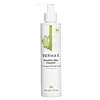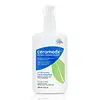What's inside
What's inside
 Key Ingredients
Key Ingredients

 Benefits
Benefits

 Concerns
Concerns

No concerns
 Ingredients Side-by-side
Ingredients Side-by-side

Water
Skin ConditioningGlycerin
HumectantPropanediol
SolventStearyl Alcohol
EmollientDecyl Glucoside
CleansingPanthenol
Skin ConditioningPinus Pinaster Bark Extract
AntioxidantAllantoin
Skin ConditioningCamellia Sinensis Leaf Extract 0.1%
AntimicrobialAloe Barbadensis Leaf Extract 0.1%
EmollientChamomilla Recutita Flower Extract 0.1%
MaskingCymbopogon Schoenanthus Extract 0.1%
Skin ConditioningXanthan Gum
EmulsifyingGlyceryl Stearate Citrate
EmollientPotassium Sorbate
PreservativePhenoxyethanol
PreservativeEthylhexylglycerin
Skin ConditioningWater, Glycerin, Propanediol, Stearyl Alcohol, Decyl Glucoside, Panthenol, Pinus Pinaster Bark Extract, Allantoin, Camellia Sinensis Leaf Extract 0.1%, Aloe Barbadensis Leaf Extract 0.1%, Chamomilla Recutita Flower Extract 0.1%, Cymbopogon Schoenanthus Extract 0.1%, Xanthan Gum, Glyceryl Stearate Citrate, Potassium Sorbate, Phenoxyethanol, Ethylhexylglycerin
Water
Skin ConditioningSodium Cocoyl Glutamate
CleansingDisodium Cocoyl Glutamate
CleansingCeramide NP
Skin ConditioningGlycine Soja Seed Extract
Skin ConditioningLinoleic Acid
CleansingLinolenic Acid
CleansingAloe Barbadensis Leaf Juice
Skin ConditioningBeta Vulgaris Root Extract
Skin ConditioningFructooligosaccharides
HumectantPyrus Malus Fruit Extract
Skin ConditioningOphiopogon Japonicus Root Extract
Skin ConditioningRosmarinus Officinalis Leaf Extract
AntimicrobialMaltodextrin
AbsorbentCitric Acid
BufferingGlycerin
HumectantSodium Levulinate
Skin ConditioningSodium Anisate
AntimicrobialSodium Phytate
Water, Sodium Cocoyl Glutamate, Disodium Cocoyl Glutamate, Ceramide NP, Glycine Soja Seed Extract, Linoleic Acid, Linolenic Acid, Aloe Barbadensis Leaf Juice, Beta Vulgaris Root Extract, Fructooligosaccharides, Pyrus Malus Fruit Extract, Ophiopogon Japonicus Root Extract, Rosmarinus Officinalis Leaf Extract, Maltodextrin, Citric Acid, Glycerin, Sodium Levulinate, Sodium Anisate, Sodium Phytate
 Reviews
Reviews

Ingredients Explained
These ingredients are found in both products.
Ingredients higher up in an ingredient list are typically present in a larger amount.
Glycerin is already naturally found in your skin. It helps moisturize and protect your skin.
A study from 2016 found glycerin to be more effective as a humectant than AHAs and hyaluronic acid.
As a humectant, it helps the skin stay hydrated by pulling moisture to your skin. The low molecular weight of glycerin allows it to pull moisture into the deeper layers of your skin.
Hydrated skin improves your skin barrier; Your skin barrier helps protect against irritants and bacteria.
Glycerin has also been found to have antimicrobial and antiviral properties. Due to these properties, glycerin is often used in wound and burn treatments.
In cosmetics, glycerin is usually derived from plants such as soybean or palm. However, it can also be sourced from animals, such as tallow or animal fat.
This ingredient is organic, colorless, odorless, and non-toxic.
Glycerin is the name for this ingredient in American English. British English uses Glycerol/Glycerine.
Learn more about GlycerinWater. It's the most common cosmetic ingredient of all. You'll usually see it at the top of ingredient lists, meaning that it makes up the largest part of the product.
So why is it so popular? Water most often acts as a solvent - this means that it helps dissolve other ingredients into the formulation.
You'll also recognize water as that liquid we all need to stay alive. If you see this, drink a glass of water. Stay hydrated!
Learn more about Water